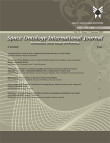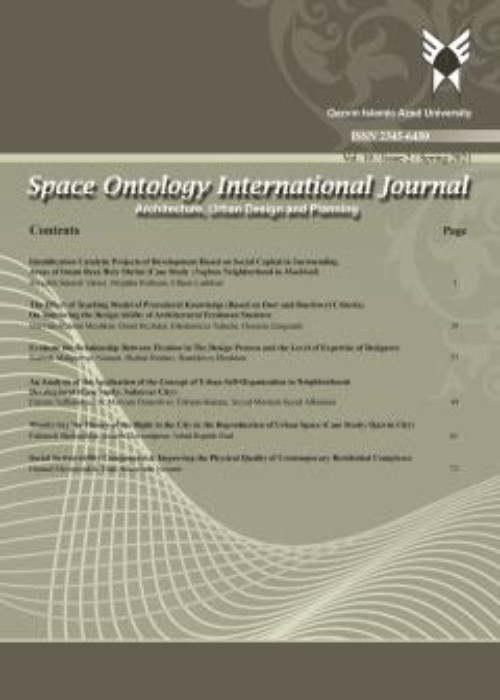فهرست مطالب

Space Ontology International Journal
Volume:11 Issue: 4, Autumn 2022
- تاریخ انتشار: 1401/11/30
- تعداد عناوین: 6
-
-
Pages 1-15
Research has shown the effect of classroom environment variables on students’ learning performance. Color, as a variable in the interior space, has great impacts on the audience’s perception of the environment. Using students’ color preferences in classes can have a significant effect on the quality of their learning. Numerous factors can affect people’s color preferences, but the question is whether educational background plays a role or not. The present study aims to evaluate the effect of educational background on students’ color preferences, so that an appropriate color will be chosen for classroom interiors to improve the quality of learning in educational environments based on the impact of choosing a given color. A total of 618 undergraduate participants majoring in computer sciences and architecture from both males and females were evaluated. In a qualitative questionnaire, students were asked to choose their first color preference as the color of the classroom interior, and then their favorite color was chosen from among the 12 main colors of the color cycle in addition to 3 achromatic colors. SPSS and Pearson's chi-squared test were used to evaluate this test. The results indicated that there is no significant relationship between students’ choice of color and their educational background in both majors (computer and architecture). However, the students’ color preferences in choosing a color for the interior of the classroom in both disciplines are affected by their educational background. This research helps us understand how to use color in the learning environments to increase the quality of learning.
Keywords: improving the quality of learning, Educational background, color preferences, internal learning environment -
Pages 17-30Today, one of the most important issues related to the industrial heritage in Iran is the rejuvenation and reuse of such assets. The industrial buildings dating from the Pahlavi era (1925-1978) have the adaptive capacity to create modern spaces. The present study seeks to answer this question: “How is the developmental approach formed with regard to industrial heritage?” Therefore, some indicators were extracted using Grounded Theory that include four effective criteria for the revitalization of industrial heritage; so they are : the effect of hidden values on the improvement of industrial heritage, capacity to adapt to new conditions, a consistent relationship between old and new structures, and development of a new combination. The study explained a theory called "Crystallization of Industrial Heritage" by analyzing the above-mentioned indicators. As myths can be crystallized in contemporary literature, it is thus possible for the industrial heritage to be crystallized in each period. Research findings show that this approach can be generalized to the revitalization of industrial heritage. In this regard, the study focused on how the industrial heritage is crystallized and the adaptation of this theory in the development of three Iranian projects. This process in the development of the Qasr cultural complex shows that this complex succeeded in inspiring crystallization once again in the modern era by creating a significant relationship between the past and present. This creativity, which is the result of combining historical aspects and modern structures for redesigning the building, transformed different old and new components into a single entity at the present era. Consequently, this not only reflects its historical identity but also represents its former values in the contemporary era. However, definition of a spatial organization consistent with the old body in two other cases has allowed for the presence of this legacy in the modern era.Keywords: industrial heritage, Grounded Theory, Revitalization, Adaptive reuse, Crystallization
-
Pages 31-47creativity is the main and necessary element in architecture education.Many thinkers and researchers around the world have thought about creativity.They have tried to solve its mystery.In terms of psychology,creativity can be seen in both convergent and divergent thinking.But it is more inclusive in divergent thinking.Adesigner with divergent thinking directs his design towards different, new and extensive situations that play a significant role in its creativity.Therefore,it is important to consider creative education in architecture education,especially for architectural design courses.The purpose of this study is to discuss creative education and how to implement it into architectural education,especially architectural design courses.The research method is mixed(quantitative-qualitative)and applied in terms of purpose.The sketch has been used to gather information from library sources and students' opinions through the questionnaire along with holding two-day workshop.The statistical population is all undergraduate architecture students(associate's and bachelor's degrees)of Karoon HigherEducationinAhvaz.To assess the students' creativity,in addition to the questionnaire formulation,the standard test of "Torrance test for creativity" has been used.The sketch testing held in two-day workshop, and Cropley's creative solution diagnosis scale(CSDS)was used to assess the sketches.To analyze the questionnaire data,SPSS software was utilized.The results of the research explain that the level of architecture students' information about creativity and ways of its development are not enough and the creativity issue is not obvious and known for most of them.It is suggested that design professors use various methods to reach the desired designs in order to achieve desired designs in order to achieve creative studios.Also,asignments should be implemented in curriculum,specially during the entry and basic courses to familiarize architecture students with the phenomenon of creativity and creative education in order to develop creativity.Authors suggest designating graduate studies and discertations on Classification of creative exercises and their learning and teaching methods in architecture to elevate the creativity in architecture courses in the country.Keywords: Creativity, Divergent Thought, Creative Thought, education, Architectural design process
-
Pages 49-59This study aims to evaluate specific elements and models used in physical learning environments and their effects on student behaviors. Specifically, the study evaluated behavioral and environmental factors and their impact on educational qualities. These behaviors include: motivation, peer interaction, team working, critical thinking, and creativity. The study further evaluated the association between two groups of behavioral and environmental factors with two closed-ended questionnaires with a sample size of n=384. The questionnaires' reliability was calculated with Cronbach's alpha. The results from the confirmatory factor analysis (CFA) and Structure Equation Modeling (SEM) revealed that the questionnaires had very good measurement properties. The collected data was analyzed using a descriptive and inferential statistics technique. The research hypotheses were tested using the SEM technique. In consequence, learning quality within SEM modules was shown dependent on external triggers. Conclusions for adequate educational settings to develop educational environments are discussed. Flexibility of design studios’ furniture arrangement and also use of architectural elements in design studios ranked the highest as the impressive environmental features in the study. At least 12 feet ceiling height for design studio ranked the lowest in the study. The richness of the findings shows that this was a relevant and efficient data collection strategy for the purpose of this study.Keywords: Physical learning environment, Personal behavior, education, Learning process, structural equation modeling
-
Pages 61-75Window to wall area ratio (WWR) is an important parameter that greatly affects the energy efficiency of a building. The aim of this research is to achieve the optimal level of the window area together with a squared geometry rotational kinematic model having horizontal axis in the south facade of an office building in Tehran.In order to evaluate the indoor daylight level, dynamic daylight indicators with WWR from 50 to 90 % and facade kinematic model have been simulatted using Grasshopper tool and Honeybee Plus plugin version 06 and Ladybug Lbt version 1.5.0. through parametric simulation were studied parametric. First kinetic facade and its movement structures are introduced, then the daylight indices and the required lighting level for an office space have been discussed. The simulation is carried out using two models of optical and thermal properties in the office building, where in the base model, the ratio of the optimal WWR is up to 60%, for a facade with a square geometric model and a rotating kinematic model with a horizontal axis.To optimize the results, the reflection coefficients of the floor, wall, the visual transmission coefficient of the glass and the viewing angle (45 to 95 degrees) were parametrically studied. The results showed that on the south facade of the office building in Tehran, using a kinetic facade with a rotational kinematic model and horizontal axis, the optimal WWR is 50%.Keywords: window to wall ratio, kinetic facade, kinematic model, dynamic daylight, Simulation
-
Pages 77-91The land is the ground for human activity and a place to meet all the resources needed by man. In other words, the geography of consumption plays a vital role in the development or non-development of modern cities. The current study is applied research in terms of the objective and descriptive-analytical in terms of the nature and method. The data collection has been performed using documentary-based and library-based methods and interviews with the experts and the citizens’ questionnaire (384 samples). The samples have been selected using snowball and random sampling methods. The mean land-use indicators have been investigated by the T-test in the SPSS. The findings indicate that among the components effective on the land consumption in Ousahn, Fasham, and Meigoun, the proximity with Tehran metropolis, water resources, and access to tourist attractions have been most effective with mean values of 8.42, 8.34, and 8.26, respectively. Also, among the indicators effective on the land consumption in Oushan, Fasham, and Meigoun, the economic policies of the government, accessibility, and climate have been the most effective with mean values of 7.84, 7.75, and 7.41, respectively. The results indicated that the changes in land-use patterns in Oushan, Fasham, and Meigoun could be explained in five periods. These changes are more affected by the urban land consumption, natural factors, and infrastructural developments, especially in terms of accessibility, i.e., proximity with the Tehran metropolis, more than the increase in urban population. The 2000s have been the initiation point of the huge evolution in the area of land in the region. In this decade, with the initiation of construction of the second home for the tourists, the way for mass land consumption in the cities was paved, which was followed by the increase in inflation and the land prices.Keywords: Thematic analysis, effective factors, land consumption, OushanFashamMeigoun


